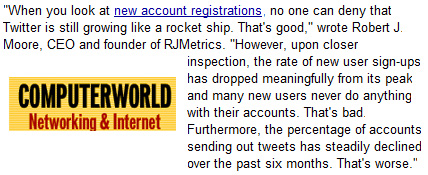[RJMetrics makes hosted business intelligence software for online businesses. Follow us @RJMetrics]
Let’s face it: the “Twitter is Awesome” storyline is so 2009. The rise of the micro-blogging service is old news, and it’s clear that reporting on Twitter’s success is not driving pageviews like it used to.
As a result, reporters are treating Twitter like any other celebrity: when the good news stops selling, pray for a downfall. If Britney Spears has taught us anything, it’s that celebrity downfalls are a media goldmine. When you consider Twitter’s meteoric rise as one of the biggest stories of 2009, it’s no surprise that reporters would salivate over any contradictory news about the company in 2010.
How did I reach these cynical conclusions? Well, last month I posted an updated set of Twitter data based on information from the company’s API. This was in conjunction with a story over at MIT Technology Review.
MIT Technology Review Piece
The findings were extremely consistent with ones I published in TechCrunch last year (which came out while Twitter’s buzz was still peaking). What was different this time was the number of news outlets who covered the report: around 200 globally by my count. Thats about 10x more than last year’s nearly identical piece attracted.
While I considered my findings to be generally positive, what I found remarkable was how many blogs and media outlets chose to selectively reprint these findings, spin them negatively, and (in a few cases) present the data incorrectly or irresponsibly. Almost every writer put the negative elements of the report front-and-center, making it clear to me that many media outlets are pushing a new storyline: “Twitter isn’t so Awesome After All.”
Below are a few examples that really stood out.
Partial Quotes
Toward the end of my report, I provided five bullet points of summary findings. They start out with what looks bad on the surface, but then dive in deeper to reach a more informed, balanced conclusion. This piece and many others, however, manufactured a “quote” from me by taking the first three bullet points (which make things sound pretty dire for Twitter) and excluding the rest of them. This put my words way out of context.
Where’s the rest?
Fun With Ellipses
The line below is a great example of a blogger who cherry-picked the most negative sentence fragments from the report and strung them together to support his thesis.
Some bloggers boiled the report down to its most negative findings
Unfair Comparisons
This article said that “According to a study by RJMetrics Inc., only 17 percent of all Twitter users used the site in the last month, down [from] more than 70 percent in early 2007.” This is technically true, but it omits the fact that Twitter only had 20,000 users at the start of 2007. By the middle of 2007, that same stat was down around 20% where it has held relatively steady for over two years now. That’s hardly a new development.
It is true that the “Tweeters by Month” number has been gradually slipping in the past few months. Apparently, however, that alone wasn’t drastic enough a visual so this blogger added a massive downward arrow to drive the point home. That image reappeared on about five times as many blogs as our original chart without the giant arrow.
Nice Arrow!
Sensationalizing
We were very careful to not use words like “inactive” or “abandoned” when describing Twitter accounts we profiled. This is because our analysis didn’t factor in the many Twitter users who use the service to read Tweets exclusively, nor does it factor in dormant users who haven’t tweeted recently but may come back. Many writers, however, weren’t so careful. It was hard to find an article that didn’t call these accounts “abandoned” or “inactive.”
Inactive? Close enough.
Conclusion
There was a fair amount of discussion beneath most of the posts on this subject, with comments landing all over the map. On social media blogs, readers passionately defended Twitter as “useful no matter how many people are active,” whereas general news sites attracted joyful readers saying things like “I knew it” and “Twitter is annoying!”
These strong reactions help make the picture clearer. A negative story about Twitter is accessible to the vast majority of Americans who have heard of Twitter but aren’t Twitter users. In a way, they validate a non-user’s decision to not bother with another fad. This, in turn, puts Twitter users on the defensive, causing them broadcast their thoughts even more than usual. This drives clicks. This sells magazines. Maybe these reporters know what they’re doing after all.
Regardless of why these stories came to be, Twitter shouldn’t worry. They’re still adding new users like gangbusters and, if there’s one thing the American public loves more than a downfall, it’s a glorious comeback. Look for that in 2011.
[RJMetrics makes hosted business intelligence software for online businesses. Follow us @RJMetrics]




